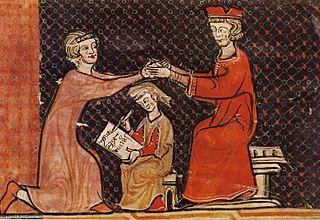| English feudalism |
|---|
 |
| Manorialism |
| Feudal land tenure in England |
| Feudal duties |
| Feudalism |
An oath of fealty, from the Latin fidelitas (faithfulness), is a pledge of allegiance of one person to another.
| English feudalism |
|---|
 |
| Manorialism |
| Feudal land tenure in England |
| Feudal duties |
| Feudalism |
An oath of fealty, from the Latin fidelitas (faithfulness), is a pledge of allegiance of one person to another.
In medieval Europe, the swearing of fealty took the form of an oath made by a vassal, or subordinate, to his lord. "Fealty" also referred to the duties incumbent upon a vassal that were owed to the lord, which consisted of service and aid. [1]
One part of the oath of fealty included swearing to always remain faithful to the lord. The oath of fealty usually took place after the act of homage, when, by the symbolic act of kneeling before the lord and placing his hands between the hands of the lord, the vassal became the "man" of the lord. Usually, the lord also promised to provide for the vassal in some form, either through the granting of a fief or by some other manner of support. [2] Typically, the oath took place upon a religious object such as a Bible or saint's relic, often contained within an altar, thus binding the oath-taker before God. Fealty and homage were key elements of European feudalism.
Fealty is distinct from other parts of the homage ceremony, and is usually used only to refer to that part of the ceremony where a vassal swore to be a good vassal to his lord. [3]
In medieval Europe, an oath of fealty (German: Lehnseid) was a fundamental element of the feudal system in the Holy Roman Empire. It was sworn between two people, the feudal subject or liegeman (vassal) and his feudal superior (liege lord). The oath of allegiance was usually carried out as part of a traditional ceremony in which the liegeman or vassal gave his lord a pledge of loyalty and acceptance of the consequences of a breach of trust. In return, the liege lord promised to protect and remain loyal to his vassal. This relationship formed the basis of landholding, known as feudal tenure, whereby the seizin vested in the tenant (the vassal) was so similar to actual possession that it was considered a separate estate described as utile domain ( dominium utile ), literally "beneficial ownership", whereas the landlord's estate was referred to as eminent domain or superiority ( dominium directum , lit. "direct ownership").
In the Late Middle Ages, the investiture and oath of fealty were invariably recorded by a deed; in modern times, this replaced the traditional ceremony. Where the geographical distance between the two parties was significant, the lord could name a representative before whom the oath was to be sworn.
The whole contract including the oath of fealty was part of a formal commendation ceremony that created the feudal relationship. [2]
The term is also used by English-speakers to refer to similar oaths of allegiance in other feudal cultures, as with medieval Japan, as well as in modern organized crime.

Feudalism, also known as the feudal system, was a combination of legal, economic, military, cultural, and political customs that flourished in medieval Europe from the 9th to 15th centuries. Broadly defined, it was a way of structuring society around relationships derived from the holding of land in exchange for service or labour.

A fief was a central element in medieval contracts based on feudal law. It consisted of a form of property holding or other rights granted by an overlord to a vassal, who held it in fealty or "in fee" in return for a form of feudal allegiance, services or payments. The fees were often lands, land revenue or revenue-producing real property like a watermill, held in feudal land tenure: these are typically known as fiefs or fiefdoms. However, not only land but anything of value could be held in fee, including governmental office, rights of exploitation such as hunting, fishing or felling trees, monopolies in trade, money rents and tax farms. There never existed a standard feudal system, nor did there exist only one type of fief. Over the ages, depending on the region, there was a broad variety of customs using the same basic legal principles in many variations.

A vassal or liege subject is a person regarded as having a mutual obligation to a lord or monarch, in the context of the feudal system in medieval Europe. While the subordinate party is called a vassal, the dominant party is called a suzerain. The rights and obligations of a vassal are called vassalage, while the rights and obligations of a suzerain are called suzerainty. The obligations of a vassal often included military support by knights in exchange for certain privileges, usually including land held as a tenant or fief. The term is also applied to similar arrangements in other feudal societies.

A commendation ceremony (commendatio) is a formal ceremony that evolved during the Early Medieval period to create a bond between a lord and his fighting man, called his vassal. The first recorded ceremony of commendatio was in 7th century France, but the relationship of vassalage was older, and predated even the medieval formulations of a noble class. The lord's "man", might be born unfree, but the commendatio freed him.
Examples of feudalism are helpful to fully understand feudalism and feudal society. Feudalism was practiced in many different ways, depending on location and period, thus a high-level encompassing conceptual definition does not always provide a reader with the intimate understanding that detailed historical examples provide.

In medieval and early modern Europe, a tenant-in-chief was a person who held his lands under various forms of feudal land tenure directly from the king or territorial prince to whom he did homage, as opposed to holding them from another nobleman or senior member of the clergy. The tenure was one which denoted great honour, but also carried heavy responsibilities. The tenants-in-chief were originally responsible for providing knights and soldiers for the king's feudal army.

A demesne or domain was all the land retained and managed by a lord of the manor under the feudal system for his own use, occupation, or support. This distinguished it from land sub-enfeoffed by him to others as sub-tenants. In contrast, the entire territory controlled by a monarch both directly and indirectly via their tenant lords would typically be referred to as their realm. The concept originated in the Kingdom of France and found its way to foreign lands influenced by it or its fiefdoms.
A lordship is a territory held by a lord. It was a landed estate that served as the lowest administrative and judicial unit in rural areas. It originated as a unit under the feudal system during the Middle Ages. In a lordship, the functions of economic and legal management are assigned to a lord, who, at the same time, is not endowed with indispensable rights and duties of the sovereign. Lordship in its essence is clearly different from the fief and, along with the allod, is one of the ways to exercise the right.
In the law of the Middle Ages and early modern period, especially within the Holy Roman Empire, an allod, also allodial land or allodium, is an estate in land over which the allodial landowner (allodiary) had full ownership and right of alienation.
Homage or Hommage (French) may refer to:

The Treaty of Falaise was a forced written agreement made in December 1174 between the captive William I, King of Scots, and Henry II, King of England.

Homage in the Middle Ages was the ceremony in which a feudal tenant or vassal pledged reverence and submission to his feudal lord, receiving in exchange the symbolic title to his new position (investiture). It was a symbolic acknowledgement to the lord that the vassal was, literally, his man (homme). The oath known as "fealty" implied lesser obligations than did "homage". Further, one could swear "fealty" to many different overlords with respect to different land holdings, but "homage" could only be performed to a single liege, as one could not be "his man" to more than one "liege lord".
Carucage was a medieval English land tax enacted by King Richard I in 1194, based on the size—variously calculated—of the taxpayer's estate. It was a replacement for the danegeld, last imposed in 1162, which had become difficult to collect because of an increasing number of exemptions. Carucage was levied just six times: by Richard in 1194 and 1198; by John, his brother and successor, in 1200; and by John's son, Henry III, in 1217, 1220, and 1224, after which it was replaced by taxes on income and personal property.

In the feudal system of the European Middle Ages, an ecclesiastical fief, held from the Catholic Church, followed all the laws laid down for temporal fiefs. The suzerain, e.g. bishop, abbot, or other possessor, granted an estate in perpetuity to a person, who thereby became his vassal.

Georgian feudalism, or patronkmoba, as the system of personal dependence or vassalage in ancient and medieval Georgia is referred to, arose from a tribal-dynastic organization of society upon which was imposed, by royal authority, an official hierarchy of regional governors, local officials and subordinates. It is thought to have its roots into the ancient Georgian, or Iberian, society of Hellenistic period.
Feudal aid is the legal term for one of the financial duties required of a feudal tenant or vassal to his lord. Variations on the feudal aid were collected in England, France, Germany and Italy during the Middle Ages, although the exact circumstances varied.
Dominium directum et utile is a legal Latin term used to refer to the two separate estates in land that a fief was split into under feudal land tenure. This system is more commonly known as duplex dominium or double domain. This can be contrasted with the modern allodial system, in which ownership is full and not divided into separate estates—a situation known as dominium plenum "full ownership".

Feudalism as practiced in the Kingdoms of England during the medieval period was a state of human society that organized political and military leadership and force around a stratified formal structure based on land tenure. As a military defence and socio-economic paradigm designed to direct the wealth of the land to the king while it levied military troops to his causes, feudal society was ordered around relationships derived from the holding of land. Such landholdings are termed fiefdoms, traders, fiefs, or fees.
Feudalism in the Holy Roman Empire was a politico-economic system of relationships between liege lords and enfeoffed vassals that formed the basis of the social structure within the Holy Roman Empire during the High Middle Ages. In Germany the system is variously referred to Lehnswesen, Feudalwesen or Benefizialwesen.
Love service is a ritualized form of male love-devotion toward women, especially noble women, that was popularized in the Middle Ages.